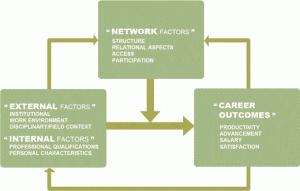he NETWISE research group is a multi-institutional research group that conducts research on questions related to how social and professional networks matter in the careers of academic scientists, with special attention to women and underrepresented minorities.
The underrepresentation of women and the “invisibility” of minorities in academic science are recognized to be a significant national policy crisis and “waste” of human capital (NAS, 2007). A common thread in many of studies regarding the advancement of women and minorities in STEM fields is reference to the importance of professional networks. We hope to contribute to both the theoretical understanding of how networks matter in the career advancement of academic scientists, but also to provide findings that will be useful in improving practice.
Our research is funded through two major National Science Foundation grants:
- NETWISE I: Women in Science and Engineering: Network Access, Participation, and Career Outcomes (NSF Grant # REC-0529642)
- NETWISE II: Empirical Research: Breaking through the Reputational Ceiling: Professional Networks as a Determinant of Advancement, Mobility, and Career Outcomes for Women and Minorities in STEM (NSF Grant # DRL-0910191)


